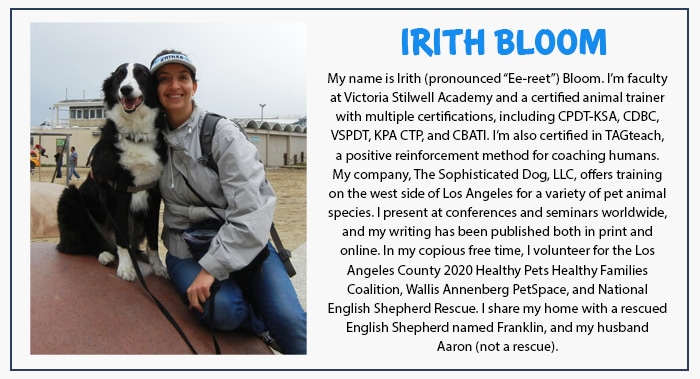I see a lot of dog behavior problems in my work. Many clients come to me because their dogs pull on the leash, jump on guests or bark excessively. Others have dogs with even more serious dog behavior problems, such as biting people or other animals.
Different dog behaviors, and different dogs, require different training protocols—which is why it’s so important to consult a Certified Dog Behavior Consultant, Certified Applied Animal Behaviorist or Veterinary Behaviorist. These behavior experts know how to create a plan to safely address dog behavior problems and teach dog obedience. One important thing they all understand is that addressing dog behavior problems involves more than just positive dog training; it also involves proper dog behavior management.
What is Dog Behavior Management?
Dog behavior management refers to changing the environment to help prevent the animal from successfully practicing the problem behavior. After all, practice makes perfect. If the dog keeps biting the mailman, he’s going to get better at it (and you will likely be facing an ugly lawsuit, too). It’s essential to prevent the problem behavior from happening while implementing positive training to change the dog’s behavior.
Management can also help keep people safe while the dog is learning new skills (as in the example above). And management isn’t just for extreme cases that involve behaviors like biting. A dog who is jumping out of exuberance can knock someone over. A dog who rushes up to greet everyone while on leash can pull down and injure his handler. Dog behavior management is a key piece of any good behavior modification plan.
So what might dog behavior management look like? Well, for a dog who is jumping up on visitors as they enter, we might put up a gate to keep the dog away from the door while people enter. A no-pull harness makes it harder for the dog to pull on the leash and drag his handler around. A gate might also keep the dog out of the kitchen so he doesn’t get up on the counter and steal food. In each of these situations, we are changing how the environment is set up to make the dog behavior problems more difficult or impossible to practice.
Use Training to Change the Behavior
Once proper management is in place, you can begin positive dog training to change the dog behavior problems. The gold standard is to use positive reinforcement to teach the dog a different behavior he can perform in the problem scenario. That way he still gets rewarded, but for a behavior we like better. For example, a classic alternative behavior for dog jumping is having the dog sit—though it can take a while to train the sit strongly enough for such an exciting situation. Whatever behavior you choose, it’s important to use positive reinforcement methods to teach dog obedience while also managing the environment so that you can set your pup up for success instead of accidentally reinforcing the dog behavior problems.
Combining Management and Training Methods
Let’s take a puppy who is chewing on shoes. First, we’d manage the environment by putting all the shoes away. Then we’d teach the dog to chew on appropriate objects such as a chew toy. We might need to make that toy extra enticing at first, by wiggling it around to catch the dog’s eye. It would also be important to avoid chasing the dog around when he steals a shoe, since most dogs think a game of chase is great fun.
In this situation, the alternative behavior we are training is chewing on an appropriate dog toy, so our focus would be on encouraging and reinforcing that new behavior. I also generally recommend teaching a cued “Drop it” behavior for the times when dog behavior management fails and the dog steals a shoe. Once the “Drop it” behavior is trained, we can reinforce the dog for dropping inappropriate chew items by either feeding dog treats or handing the dog a suitable toy. Eventually, chewing on toys would become the dog’s go-to behavior, and we’d be able to relax a bit more about where we put our shoes.
Training vs. Managing Dog Behavior
All behavior happens in a context. The stuff that happens before the behavior—what is technically called the “antecedents”—is what we target with management. Sometimes management alone is good enough. If your dog calms down 10 minutes after guests arrive, putting him behind a gate for the first 10 minutes may be all you need to do to get rid of the dog’s jumping behavior.
Not all dog obedience can be enforced with management alone, so in most cases we’ll also need to use training to address dog behavior problems. Training focuses on what happens after the behavior—what we call the “consequences” or “postcedents.” As mentioned above, in a good behavior modification plan, positive reinforcement training methods are used to teach alternative behaviors the animal can perform to get good things such as food, attention and petting. The alternative behavior is then asked for and reinforced as often as possible—especially in the situation where the problem behavior used to happen.
At the same time, if the behavior does occur, it is ignored, or the dog is redirected to a more appropriate behavior. For example, you might let your dog run off with the shoe and wait for him to get bored and let go of it. Another option would be to wiggle a toy at him so he drops the shoe and comes to chew on the toy instead.
Management is used to make sure the dog can’t practice dog behavior problems. Positive dog training is used to change the consequences (or postcedents) to encourage alternative behaviors we like better in the problem situation. Through a combination of dog behavior management and training, we can change a problem situation (the environment in which the problem behavior happens) into an environment that encourages dog behaviors we like better.

Share:














